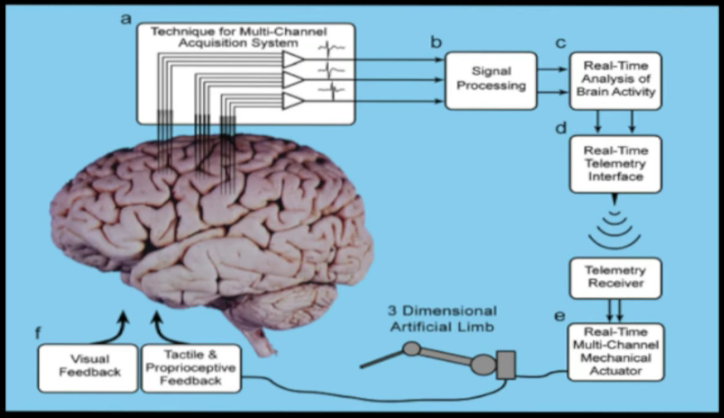Brainstorms
Try to imagine this:
A rhesus monkey seated in a research chair at Duke University, gets a drop of orange juice whenever it accomplishes a task.
The task is to play a video game and hit a target, using a joystick like kids do.
The monkey, named Aurora, learns the task, and gets her orange juice.
Then they take away the joystick.
So in a short time, watching her video screen, Aurora teaches herself to hit the target WITHOUT any joystick, but just using her brain, and the waves that it emits.
A bit like yours as you read this. Sorry. No orange juice.
Next...
Another rhesus in the same lab, learns to run on a treadmill, with a similar system of reward (Do you like Brazilian orange juice?).
In a lab in Kyoto, Japan, is a robot that can walk. It walks in response to brain waves, since it is equipped with the equivalent of an EEG machine that senses brain waves. Here's what happens next:
- The rhesus runs on the treadmill in North Caroline, looking in real time by video at the robot in Kyoto.
- Without being wired up in any way, the rhesus sends its brain waves to the robot, telling it to walk.
- That the robot in Kyoto is now walking is shown by video to the rhesus in North Carolina, which adjusts its thoughts to make the robot walk faster and with more stabilty.
- The time it takes for the rhesus to "think" his brain waves to Kyoto, Japan is about 20 milliseconds. Less than the time required for its brain to send the same message to its own leg, to make it move via neurons and axons we call "nerves" that innervate its muscles, and send back info about where it has just placed its foot.
- The rhesus gets a drop of orange juice. But the reward does not come as a function of what she does with her body, but by every correct step that she is instructing the robot to take on the other side of the planet. From Duke, she adjusts the robots movement in Kyoto.
Dr. Miguel Nicolelis, Neuroscientist, has been working on this for over 30 years.
The meaning of this, according to Nicolelis?
Here is his 15 min TED talk, quite worth the time ...
And here an article from the Business section of VentureBeat about the same subject.
So what have you been thinking about lately?
Wait, let me tell you ... is your nose itching?
So this would be called Brain-to-Brain Communication. Which puts us very quickly into the "woo-woo" stuff of today, and people who pretend to know what Quantum Mechanics is all about. But this is actually, pretty good science. No, phenomenally good science. And soon a miracle will happen in which someone says: "Get up and walk," and the paralyzed person will first think about it, then do it.
Here's the schematic of how to do this, if you're interested in building your own:
Of course. Seems logical. Imminently doable. (His colleagues in NeuroEngineering called him nuts).
Thirty years of research planning, and 15 years to realize it. So watch this ...
18 months of work, by a huge interntional team, brought together in Brazil. Now that is where our world is today.
Resumé :
- A monkey, seeking a reward, thinks a thought.
- That thought is a method. A way of accomplishing a task, no matter what obstacle needs to be overcome, to get from here to there.
- The monkey studies, practices, learns from its failures, tries again, and acquires knowledge for the task.
- An INTERFACE gets the thought out of the monkey's brain. It might be an electrode or several implanted in the brain with wires leading out, or it might be a skull cap, fitted with captors or electrodes that pick up monkey brain waves, and transmits them. Like an EEG.
- When the task is not met: no reward. When it is: reward.
- When the task is not met: the monkey changes it's thoughts, until the machine, or arm, or robot, moves in the desired manner.
- Humans with neurologic deficits (paraplegics) equipped with (1) a skullcap with electrodes (one eventually could implant them permanently like in the monkey), and (2) a machine, in this case an "exoskeleton" with motors and controls wired to respond to human thought, moves the human who cannot move on his own, but through thought, makes the machine move as desired. Learning, creativity, knowledge required.
What do they know, that we haven't learned yet?
Two questions ...
Dr. Nicolelis allows himself to see this as an inroad to Brain-to-Brain Communication. In the above, I have placed INTERFACE in caps. This because it is the tool that we are seeking, to SendThemPeace.
1. Can we imagine an interface, without wires, that gets our thoughts, and even more, our very personal energy, out of our heads, our hearts, our selves,... and into the world?
2. To make this wireless tool work, does it require a reward for the human? What would that reward be? I assume in this setting, that it would be seeing Non-Peace and Ego-motivated Destruction, manifest as Peace and Compassion. I would find that rewarding. How about you?
Are there at present ...
any such "wireless" disciplines, practices, methods, tools, ... already in use, and effective at getting the task done?
Just like Aurora the monkey learned to do, masterfully, while at a distance from the object in need of liberation.
Let’s look around some more in our toolbox ...



